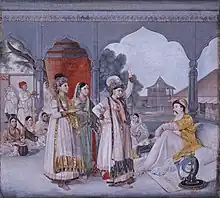William Hamilton Bird
William Hamilton Bird was an Irish musician who was active in India during Company rule. He was a pioneer in transcribing Indian music into western notation.[1]
The publication for which he is remembered appeared in Calcutta (now known as Kolkata) the capital of British-held territories in 1789. The Oriental Miscellany; being a collection of the most favourite airs of Hindoostan, compiled and adapted for the Harpsichord consists of about 30 pieces plus a flute sonata. The book was republished in Edinburgh (c. 1805 after Bird's death) with a slightly different selection of pieces.
Biography
Little is known of Bird´s early life. He appears to have come from Dublin, and by his own account he travelled to India in about 1770, remaining there until the 1790s.
Bird's transcriptions of Indian music can be seen in the broad context of European interest in "national" music, evidenced by publications of Irish and Scottish folk-song arrangements, such as "25 Scottish Songs" (Beethoven). They can also be seen in the context of a mingling of cultures in late 18th century India, as described, for example by the historian William Dalrymple.[2] The first edition of Bird's work was dedicated to Warren Hastings, the de facto Governor-General of India from 1773 to 1785. Hastings was interested in Indian music and Indian culture generally, he had promoted the first translation into English of the Bhagavad Gita. Other members of the British community who were interested in Indian music included:
- the judge Sir William Jones, who arrived in Calcutta in 1783. Best remembered as a philologist, his work "On the Musical Modes of the Hindus" was published posthumously in 1799.[1] He is known to have been involved in the transcription of song lyrics.[3]
- Sophia Plowden, an amateur musician who arrived in Calcutta in 1777 and also lived in the princely state of Lucknow. Plowden was one of the 250 subscribers to the "Oriental Airs".[4]
The music came from an oral tradition, and we are not in a position to compare the transcriptions directly with the original versions. However, there is little doubt that in various ways, Bird's transcriptions are not faithful to the original versions:
- Bird avoided microtonality (shruti), a feature of Indian music. The tuning system of the main instrument he featured, the harpsichord, does not give much scope for microtonality.
- in the introduction to the Miscellany, Bird indicates that he struggled with Indian rhythms. When adapting the music to western taste, he avoided the more complicated rhythms, working with multiples of two or three beats per bar.[5] Katherine Butler Schofield suggests that where the lyrics survive their metres call for more complicated rhythms, such as seven beats per bar, which would have been outside the experience of musicians in Europe.[6]
- he added harmonies, whereas the Indian tradition is monophonic.
Sources

Bird appears to have collected his material from live performances of genres such as tappa (a mainly vocal tradition). Sometimes he indicates the singer associated with the piece.
Sophia Plowden
Bird's transcriptions appear to reflect the work of uncredited collaborators such as Sophia Plowden. Katherine Butler Schofield has examined the evidence that Plowden was Bird's source for some of the tunes he published. She was a fan of the nautch girl Khanum Jan, one of the singers referenced in Bird's work. She compiled her own collection of airs from the court of Lucknow, a manuscript which is preserved in the Fitzwilliam Museum, Cambridge. Plowden wrote down lyrics as well as music, and she thus facilitates the restoration of North Indian words to some of the pieces in Bird's book (which supplies Urdu titles but not lyrics).[7][5]

Live and recorded performances
The British label Signum Classics released a recording of the "Oriental Miscellany" in 2015 featuring the harpsichordist Jane Chapman.[5] It received international attention.[8] Jane Chapman had studied the music in a project supported by the Leverhulme Trust.[4] She played a 1722 Jacob Kirckman instrument in the Horniman Museum, London.[9] For the recording it was tuned in Vallotti temperament,[10] an alternative to equal temperament (the norm in Western music). This non-standard tuning gives the player more scope for an approximation of the modes (ragas) of Indian music.
Bird's work is also in the repertoire of other harpsichordists, for example Mahan Esfahani.[11]
See also
References
- Hewett, Ivan (3 May 2015). "The man who discovered Indian music". www.telegraph.co.uk. Retrieved 21 April 2018.
- Ziegler, P (2002). "A romance famous in the east (review of White Mughals)".
The tone of this early period of British life in India seemed instead to be about intermixing and impurity, a succession of unexpected and unplanned minglings of peoples and cultures and ideas.
- Woodfield, Ian (1994). "Collecting Indian Songs in Late 18th-Century Lucknow: Problems of Transcription". British Journal of Ethnomusicology. 3: 73–88. doi:10.1080/09681229408567227. JSTOR 3060807. accessed via JSTOR, subscription required
- "Jane Chapman: artist in residence at the Foyle Special Collections Library". King's College London. Retrieved 13 October 2018.
- Kennicott, P (10 July 2015). "William Hamilton Bird: The Oriental Miscellany". Gramophone.
- "The Courtesan and the Memsahib: Khanum Jan Meets Sophia Plowden at the 18C Court of Lucknow". Histories of the ephemeral (Podcast).
- Schofield, Katherine B (June 2018). "Sophia Plowden, Khanum Jan, and Hindustani airs". British Library. This is a written introduction to a podcast 'The Courtesan and the Memsahib: Khanum Jan Meets Sophia Plowden at the 18C Court of Lucknow', part of a series 'Histories of the Ephemeral: Writing on Music in Late Mughal India'
- Khurana, S (2015). "Of clefs and chords". The Indian Express.
- "Harpsichord". www.horniman.ac.uk. Retrieved 21 April 2018.
- O´Regan, N. (2015). "The Oriental Miscellany". Early Music Review.
- "Programme note: 'El otro exotico' (concert given in Madrid in March 2018 in the series 'The East and Western Music')". Fundación Juan March (www.march.es). Retrieved 21 April 2018.